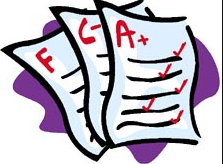You may disagree with me, but I do think this is worth saying: You are wasting your time in the classroom and your personal time grading at home by assigning writing without explicitly teaching the writing process. And by process I do not simply mean a graphic organizer.
This, officially called by education researchers, “Writing Process Approach,” is defined as teaching each step of planning, organizing, drafting, revising, and reflecting. It not only has statistically proven to improve writing but it has also proven to relieve the inevitable anxiety. A study in 2014 concluded that since most of the anxiety stems from being graded, students were less fearful of the grade because the focus was spent on the process and not the final product. And, the students’ final product have less mistakes, so students grades tend to be higher. (Bayat, p.1139)
For me, I find that the process approach yields stronger writing. My high expectations each year are consistently met because of the incremental steps I take with my students.
Here is a compilation of research-based strategies mixed with strategies I have picked up over the years from various colleagues and conferences for teaching formal writing. They might not all work for you, but if you are interested in adopting a process-approach, there are hopefully a couple nuggets for you.
Planning
This would be the step following or coinciding with the preliminary research where students gather information and textual evidence to use when they write. A study done in 2002 had kids memorize and use pneumonic devices, like PLAN, so that they could do this on their own. According to this research, students who were taught how to use and to memorize these pneumonic devices wrote “essays that were longer, contained more mature vocabulary and were qualitatively better.” (De La Paz and Graham 2002, p. 687) I find this alone to be a bit elementary. I talk about how to expand this a little later.
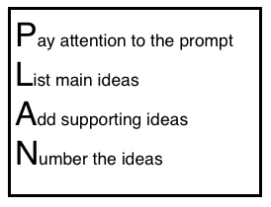 Organizing
Organizing
Here is the next pneumonic device in the conclusive study that the process approach works:
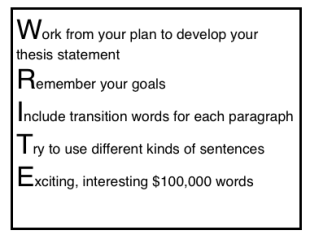
Writing a thesis statement can be intimidating for students. I use the DBQ Project’s chicken foot method for the standard five paragraph essay, but the most important part of the puzzle is that first part: topic + opinion (without saying, “I think,” or “I believe.”)
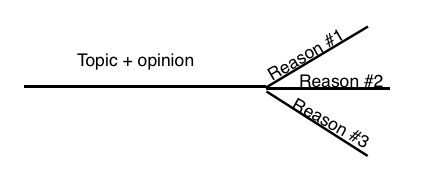
How valuable would it be for kids to realize that thesis statements should really be in all forms of writing (well, except for creative writing). History, response to literature, science, and even math writing can utilize the common vocabulary. For more complex thesis statements, for 8th graders, Jill requires them to add a phrase in the beginning acknowledging that the statement about to be said can be refuted. Phrases start with “although” or “while.”
When organizing complex essays that expand to numerous topics and body paragraphs, students can break down their main ideas from the PLAN and WRITE phase to body paragraph topics. Each body paragraph topic could be listed on a separate page. And students can organize and number their supporting ideas based on the paragraph topic. This really helps in the preliminary research as well.
During this phase, a graphic organizer can be useful. Read Write Think has a good one! Essay Map
Drafting
While many believe students should have the freedom to choose where in the introduction to place their thesis statements, the best way to teach it is as the last sentence of the introduction. This is because it is the most logical for students to understand when first learning to write in this way, students need to understand the rules before they can break them and this is what is expected of them in high school. (Did you see how I modeled a complex thesis statement there? ) 🙂
So, obviously this is what I teach to my students. Below is a diagram that I learned from Jill many years ago that helps give students the general outline of writing a research paper or a persuasive essay. She coined him Essay Man: the ultimate writing teacher’s boyfriend…..and for you male teachers out there, Essay Woman works great too. 😉
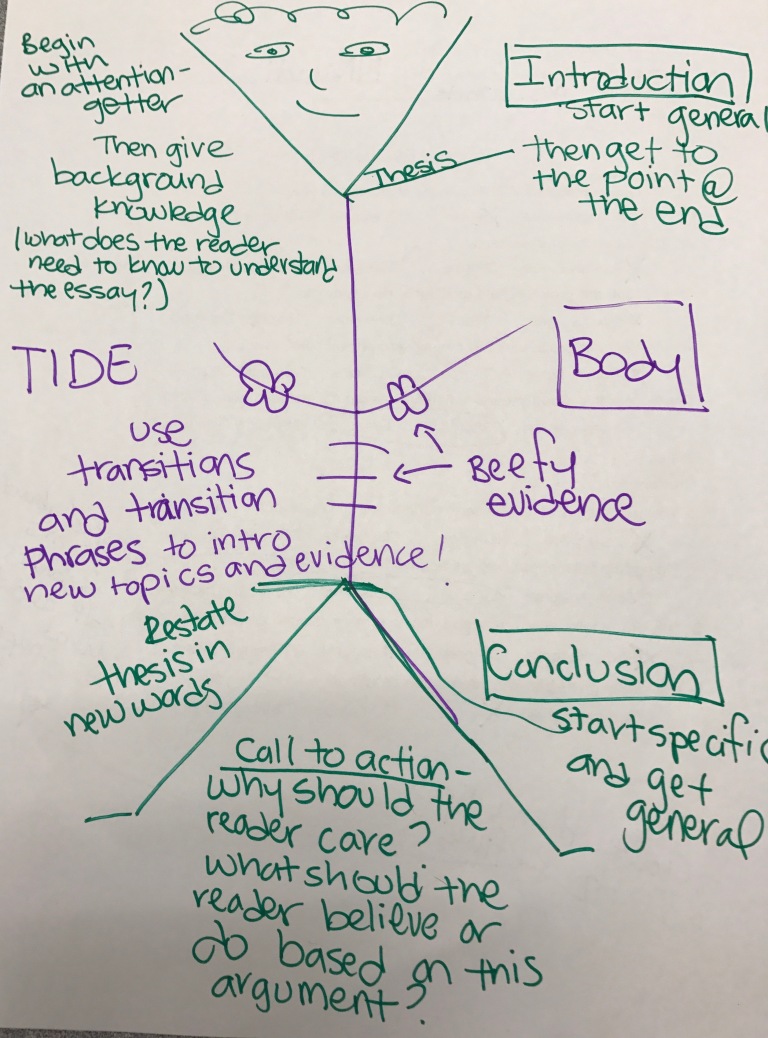
TIDE is a pneumonic device that breaks down the body paragraphs or paragraphs that stand alone. Students color code as they write. It is important to specify how many pieces of important evidence they need. For every piece of evidence, they need a detail. Ann has a ton of resources for TIDE, so see her for help!
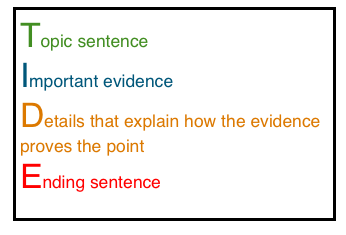
Revising:
There are many ways to skin the cat on this one: self-assessment, peer evaluation, conferencing one-on-one with students, etc. But, it should always include you, the teacher, giving them feedback at some point in the process. We have all given students copious notes for improvement after giving a grade. But, they never read them. All they care about is the grade. And, we can’t fault them for that because the grade is all that matters. (see grading blog post)
The absolute best time for feedback is during this phase of writing. I make it a rule to never sit down when they are writing. There should be regular coaching. My biggest struggle is helping the kids that don’t advocate for themselves and ask for help. So, I brought in the big guns. Kimmy and Ann are amazing assets and I encourage you to reach out to them and invite them into your classroom to help kids revise their writing. Having another teacher in the room who is an expert in helping struggling kids, especially with reading and writing, is pretty much life-changing. The amount of time your name is called goes down exponentially!
Self-assessment has also been proven to successfully improve writing. According to Kristen Nielsen (2012) in her article, “Self Assessment Methods in Writing Instruction: A Conceptual Framework, Successful Practices and Essential Strategies,” “Self-assessment in writing signifies any teaching method that prompts writers to think about, evaluate and/or respond to their own writing.” (p. 1) Nielson compiled list of include: “Teach students the criteria for rating their own work,…use writing models to demonstrate specific writing skills and to give students opportunity to practice assessment,…[and] students should participate in the development of the marking criteria.” (Nielson 2012, p.10-11)
For my last essay, I gave students a simple check list for them to go through as they read the paper. One part asked them to color code their typed document: blue for the thesis statement, red for transition statements, green for quotes. This helped me grade too, because I could quickly see whether they can identify these vocabulary words and if they know what to do with them!
Peer evaluation can be valuable when done correctly. Often, kids are paired up in mixed-ability groups. Which is so useful for the struggling student. But what about the high kid? Where is he or she getting feedback from? You also have to be very clear about the criteria they are looking for. They are not looking for grammar or punctuation mistakes, or, heaven help us, penmanship critique. They are looking at the specific writing goals (i.e. checklist) and see if there is room for coaching. It is also important that you teach them how to give feedback. Good sentence starters are “I like” for strengths and “I wonder” for improvements.
Here is a video of a silent critique activity I have done with my students that works really well. I learned this from the Deeper Learning Conference at High Tech High. (Forgive me: I did this for grad school and it is very raw!)
Reflection:
For almost every assignment I use rubrics. Not only does this tell the student why he or she lost points, but it also makes it easy for me to provide comments at the end of the semester. I can clearly see strengths and weaknesses. But, how many kids really look at the rubrics? For my persuasive essay I just did with the 6th graders, I was pretty confident none of them did. What is the point of grading, if not to teach them how they can improve? I told all of my students that they could improve their score if they met with me during office hours and resubmitted their writing based on my recommendations. Here was the rubric I used:
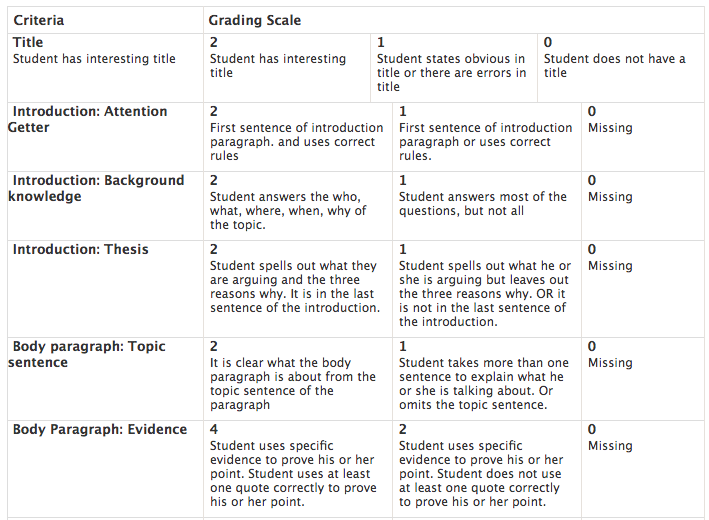
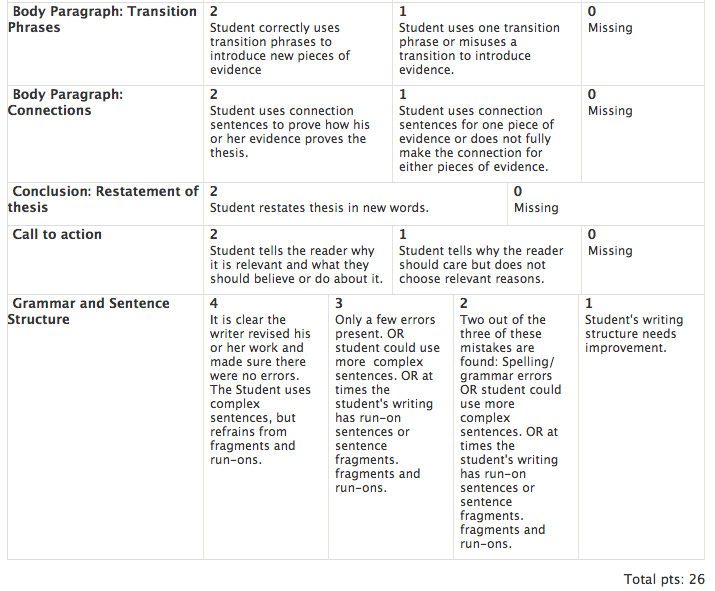
I had all of them do a reflection which forced them to look at the rubric and I made it worth almost the same amount of points as the essay itself. Here are the questions I asked.
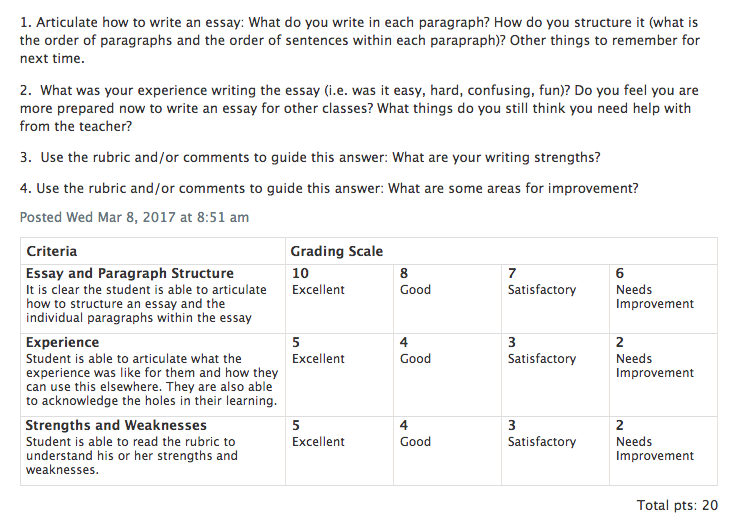
I know what you are thinking: wow, it is a lot of work to teach writing! And, that is a completely fair assessment! 🙂 I plan to follow this up with more ideas learned from other teachers. Please let me know strategies that have worked for you so I can share them!
Resources:
-
2. BAYAT, N. (2014). The Effect of the Process Writing Approach on Writing Success and Anxiety. Educational Sciences: Theory & Practice, 14(3), 1133-1141. doi:10.12738/estp.2014.3.1
-
De La Paz, S., & Graham, S. (2002). Explicitly Teaching Strategies, Skills, and Knowledge: Writing Instruction in Middle School Classrooms. Journal Of Educational Psychology, 94(4), 687.
- DBQ Project
- Nielsen, K. (2014). Self-assessment methods in writing instruction: a conceptualframework, successful practices and essential strategies. Journal Of Research InReading, 37(1), 1-16. doi:10.1111/j.1467-9817.2012.01533.x


